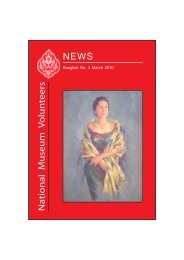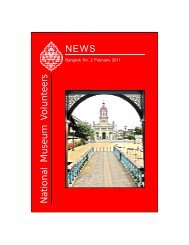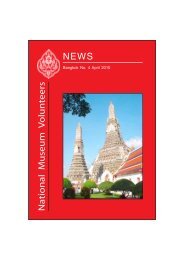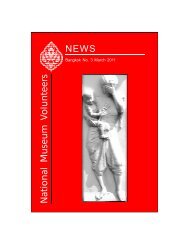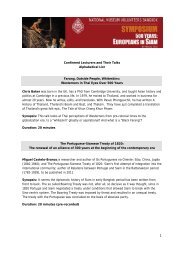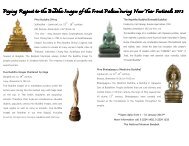November 2010 - National Museum Volunteers
November 2010 - National Museum Volunteers
November 2010 - National Museum Volunteers
Create successful ePaper yourself
Turn your PDF publications into a flip-book with our unique Google optimized e-Paper software.
longest reign of a Chakri monarch. The opening event, the unveiling of the<br />
statue on <strong>November</strong> 11th 1908 ‘was as momentous as the monument itself’.<br />
The celebration drew thousands of people. The statue may look nothing out of<br />
the norm today, but it was very new to the masses in Siam a century ago. In<br />
Siam as with other Indic cultures the animal most associated with royalty and<br />
power was not a horse but the elephant. On ceremonial occasions the King<br />
was by custom borne by officers on a palanquin. He did not ride a horse.<br />
The larger than life bronze statue was realistic, emphasizing Western aesthetics<br />
and anatomy instead of traditional idealization and mysticism. The King was<br />
shown as a cavalier, in European- style military uniform with a tasseled hat,<br />
high-top boots and a long sword on his left side. The muscular and majestic<br />
royal horse seems to bear the King effortlessly<br />
The money to build the statue was raised by public donation. Over 1,000,000<br />
baht was raised<br />
This statue has continued to touch the people dearly throughout the years since<br />
the King’s death in 1910. It is now widely worshipped as a holy idol, especially<br />
so by the cult of King Rama V (Sadej Poh Ror Ha)<br />
Thai scholars speak of the worship of King Chulalongkorn developing into a cult<br />
during the heyday of the economic boom in the 1990s. Many upper class merchants<br />
and self-employed businessmen adopted him as a patron saint. The<br />
devotees believe that faith in King Chulalongkorn can bring miracles and success.<br />
Some even think King Chulalongkorn’s spirit descends from heaven and<br />
returns to earth through this statue on Tuesdays and Thursdays.<br />
King Rama I, commissioned by King Prajadhipok (Rama VII)<br />
Reign 1925-1935<br />
From the Sixth Reign the monarchy’s immense popularity went into decline.<br />
King Rama VI lacked the charisma of his father. He had an eccentric<br />
personality and spent hugely; royal expenditure averaged ten percent of the<br />
state revenue in his reign. During the Sixth Reign there were two aborted<br />
military coups.<br />
When King Prajadhipok succeeded to the throne he made some half hearted<br />
plans for introducing a constitution and a house of representatives. Then the<br />
Great Depression hit Thailand. In an effort to rejuvenate the reputation of the<br />
Monarchical government the gigantic Monument of King Rama I was commissioned<br />
to commemorate the 150 anniversary of Bangkok in 1932. At the time<br />
there were rumours that the government would be overthrown at anytime. Also<br />
the monarchy was haunted by the old prophesy that Chakri rule would only last<br />
. <strong>November</strong> <strong>2010</strong> . Newsletter <strong>National</strong> <strong>Museum</strong> <strong>Volunteers</strong> . 27



